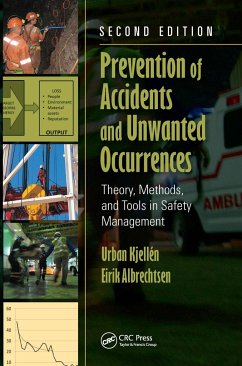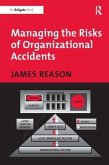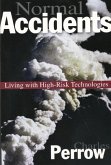Urban Kjellen (Norwegian University of Science & Trondh Technology, Eirik Albrechtsen (Norwegian University of Science and Technology
Prevention of Accidents and Unwanted Occurrences
Theory, Methods, and Tools in Safety Management, Second Edition
Urban Kjellen (Norwegian University of Science & Trondh Technology, Eirik Albrechtsen (Norwegian University of Science and Technology
Prevention of Accidents and Unwanted Occurrences
Theory, Methods, and Tools in Safety Management, Second Edition
- Gebundenes Buch
- Merkliste
- Auf die Merkliste
- Bewerten Bewerten
- Teilen
- Produkt teilen
- Produkterinnerung
- Produkterinnerung
"This is the 2nd edition of the book "Prevention of Accidents through Experience Feedback" from year 2000"--Introduction.
Andere Kunden interessierten sich auch für
![Essays On The Prevention Of Explosions And Accidents In Coal Mines (1874) Essays On The Prevention Of Explosions And Accidents In Coal Mines (1874)]() Wilfred CreswickEssays On The Prevention Of Explosions And Accidents In Coal Mines (1874)29,99 €
Wilfred CreswickEssays On The Prevention Of Explosions And Accidents In Coal Mines (1874)29,99 €![Managing the Risks of Organizational Accidents Managing the Risks of Organizational Accidents]() James ReasonManaging the Risks of Organizational Accidents42,99 €
James ReasonManaging the Risks of Organizational Accidents42,99 €![Normal Accidents Normal Accidents]() Charles PerrowNormal Accidents45,99 €
Charles PerrowNormal Accidents45,99 €![Happy Little Accidents Happy Little Accidents]() Michelle WitteHappy Little Accidents20,99 €
Michelle WitteHappy Little Accidents20,99 €![An Unwanted Guest An Unwanted Guest]() Shari LapenaAn Unwanted Guest17,99 €
Shari LapenaAn Unwanted Guest17,99 €![Overcoming Unwanted Intrusive Thoughts Overcoming Unwanted Intrusive Thoughts]() Sally M. WinstonOvercoming Unwanted Intrusive Thoughts23,99 €
Sally M. WinstonOvercoming Unwanted Intrusive Thoughts23,99 €![The Unwanted Dead The Unwanted Dead]() Chris LloydThe Unwanted Dead18,99 €
Chris LloydThe Unwanted Dead18,99 €-
-
-
"This is the 2nd edition of the book "Prevention of Accidents through Experience Feedback" from year 2000"--Introduction.
Hinweis: Dieser Artikel kann nur an eine deutsche Lieferadresse ausgeliefert werden.
Hinweis: Dieser Artikel kann nur an eine deutsche Lieferadresse ausgeliefert werden.
Produktdetails
- Produktdetails
- Verlag: Taylor & Francis Inc
- 2 New edition
- Seitenzahl: 570
- Erscheinungstermin: 14. März 2017
- Englisch
- Abmessung: 240mm x 161mm x 35mm
- Gewicht: 968g
- ISBN-13: 9781498736596
- ISBN-10: 1498736599
- Artikelnr.: 47856780
- Herstellerkennzeichnung
- Libri GmbH
- Europaallee 1
- 36244 Bad Hersfeld
- gpsr@libri.de
- Verlag: Taylor & Francis Inc
- 2 New edition
- Seitenzahl: 570
- Erscheinungstermin: 14. März 2017
- Englisch
- Abmessung: 240mm x 161mm x 35mm
- Gewicht: 968g
- ISBN-13: 9781498736596
- ISBN-10: 1498736599
- Artikelnr.: 47856780
- Herstellerkennzeichnung
- Libri GmbH
- Europaallee 1
- 36244 Bad Hersfeld
- gpsr@libri.de
Urban Kjellen, Eirik Albrechtsen
Section I: Introduction
Chapter 1 Introducing some basic concepts
Chapter 2 Framework conditions
Chapter 3 Case study
Section II: Theoretical foundation
Chapter 4 Accident theory and models
Chapter 5 Framework for accident analysis
Chapter 6 The occurrence of accidents over time
Chapter 7 Management of safety through experience feedback
Chapter 8 Criteria for assessing the efficiency of experience feedback
Chapter 9 Barriers against loss
Chapter 10 The human element in accident control
Section III: Learning from incidents and deviations
Chapter 11 Sources of data on accident risks
Chapter 12 Hazard identification, safety inspections and audits
Chapter 13 Incident reporting and investigation
Chapter 14 Accumulated incident experience
Section IV: Monitoring of safety performance
Chapter 15 Overview of safety performance indicators
Chapter 16 Loss-based safety performance indicators
Chapter 17 Process-based safety performance indicators
Chapter 18 Causal factor-based safety performance indicators
Chapter 19 Selecting safety performance indicators
Section V: Risk assessment
Chapter 20 The risk assessment process
Chapter 21 Coarse analysis
Chapter 22 Job safety analysis
Chapter 23 Risk assessments of machinery
Chapter 24 Comparison risk assessment
Section VI: Putting the pieces together
Chapter 25 The oil and gas industry
Chapter 26 The hydropower industry
Chapter 27 Work-related road transportation
Chapter 28 Epilogue
Appendix A: Definitions
Appendix B: SMORT checklists and questionnaire
Bibliography
Chapter 1 Introducing some basic concepts
Chapter 2 Framework conditions
Chapter 3 Case study
Section II: Theoretical foundation
Chapter 4 Accident theory and models
Chapter 5 Framework for accident analysis
Chapter 6 The occurrence of accidents over time
Chapter 7 Management of safety through experience feedback
Chapter 8 Criteria for assessing the efficiency of experience feedback
Chapter 9 Barriers against loss
Chapter 10 The human element in accident control
Section III: Learning from incidents and deviations
Chapter 11 Sources of data on accident risks
Chapter 12 Hazard identification, safety inspections and audits
Chapter 13 Incident reporting and investigation
Chapter 14 Accumulated incident experience
Section IV: Monitoring of safety performance
Chapter 15 Overview of safety performance indicators
Chapter 16 Loss-based safety performance indicators
Chapter 17 Process-based safety performance indicators
Chapter 18 Causal factor-based safety performance indicators
Chapter 19 Selecting safety performance indicators
Section V: Risk assessment
Chapter 20 The risk assessment process
Chapter 21 Coarse analysis
Chapter 22 Job safety analysis
Chapter 23 Risk assessments of machinery
Chapter 24 Comparison risk assessment
Section VI: Putting the pieces together
Chapter 25 The oil and gas industry
Chapter 26 The hydropower industry
Chapter 27 Work-related road transportation
Chapter 28 Epilogue
Appendix A: Definitions
Appendix B: SMORT checklists and questionnaire
Bibliography
Section I: Introduction
Chapter 1 Introducing some basic concepts
Chapter 2 Framework conditions
Chapter 3 Case study
Section II: Theoretical foundation
Chapter 4 Accident theory and models
Chapter 5 Framework for accident analysis
Chapter 6 The occurrence of accidents over time
Chapter 7 Management of safety through experience feedback
Chapter 8 Criteria for assessing the efficiency of experience feedback
Chapter 9 Barriers against loss
Chapter 10 The human element in accident control
Section III: Learning from incidents and deviations
Chapter 11 Sources of data on accident risks
Chapter 12 Hazard identification, safety inspections and audits
Chapter 13 Incident reporting and investigation
Chapter 14 Accumulated incident experience
Section IV: Monitoring of safety performance
Chapter 15 Overview of safety performance indicators
Chapter 16 Loss-based safety performance indicators
Chapter 17 Process-based safety performance indicators
Chapter 18 Causal factor-based safety performance indicators
Chapter 19 Selecting safety performance indicators
Section V: Risk assessment
Chapter 20 The risk assessment process
Chapter 21 Coarse analysis
Chapter 22 Job safety analysis
Chapter 23 Risk assessments of machinery
Chapter 24 Comparison risk assessment
Section VI: Putting the pieces together
Chapter 25 The oil and gas industry
Chapter 26 The hydropower industry
Chapter 27 Work-related road transportation
Chapter 28 Epilogue
Appendix A: Definitions
Appendix B: SMORT checklists and questionnaire
Bibliography
Chapter 1 Introducing some basic concepts
Chapter 2 Framework conditions
Chapter 3 Case study
Section II: Theoretical foundation
Chapter 4 Accident theory and models
Chapter 5 Framework for accident analysis
Chapter 6 The occurrence of accidents over time
Chapter 7 Management of safety through experience feedback
Chapter 8 Criteria for assessing the efficiency of experience feedback
Chapter 9 Barriers against loss
Chapter 10 The human element in accident control
Section III: Learning from incidents and deviations
Chapter 11 Sources of data on accident risks
Chapter 12 Hazard identification, safety inspections and audits
Chapter 13 Incident reporting and investigation
Chapter 14 Accumulated incident experience
Section IV: Monitoring of safety performance
Chapter 15 Overview of safety performance indicators
Chapter 16 Loss-based safety performance indicators
Chapter 17 Process-based safety performance indicators
Chapter 18 Causal factor-based safety performance indicators
Chapter 19 Selecting safety performance indicators
Section V: Risk assessment
Chapter 20 The risk assessment process
Chapter 21 Coarse analysis
Chapter 22 Job safety analysis
Chapter 23 Risk assessments of machinery
Chapter 24 Comparison risk assessment
Section VI: Putting the pieces together
Chapter 25 The oil and gas industry
Chapter 26 The hydropower industry
Chapter 27 Work-related road transportation
Chapter 28 Epilogue
Appendix A: Definitions
Appendix B: SMORT checklists and questionnaire
Bibliography








